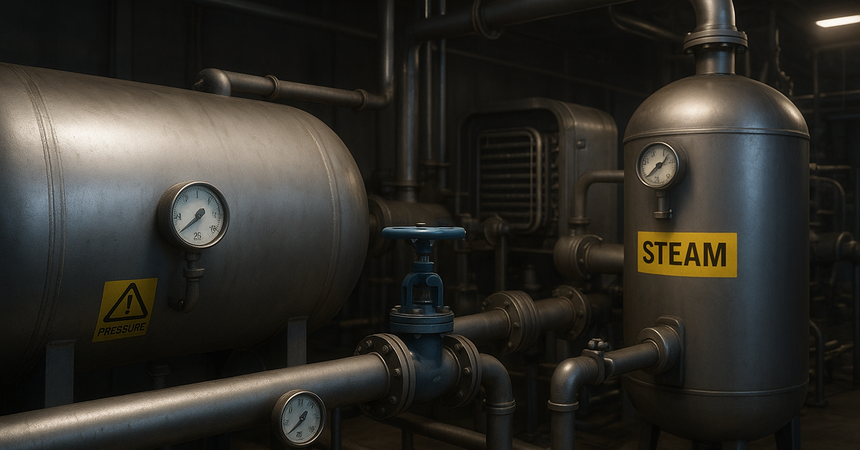- Equipment operating under excess pressure includes any products or technical devices in which internal pressure exceeds atmospheric pressure by more than 0.05 MPa.
- This category includes vessels, pipelines, boilers, heat exchangers, fittings, and various modules where the working medium is kept under the pressure of gases, vapors, or liquids.
- Such equipment is used in energy, industry, oil and gas, utilities, mechanical engineering, and other sectors where processes require heating, transport, or storage of substances under pressure.
- The key factor is not the purpose of the device but the fact that internal pressure exceeds atmospheric pressure, which automatically classifies the equipment as high-risk.
- Designing and operating such equipment requires strength calculations, certified materials, and protective devices.
- Any system elements containing a working medium under excess pressure are subject to mandatory conformity assessment before commissioning.
Equipment operating under excess pressure covers a wide range of devices used in both domestic and industrial environments. One of the most common examples is pressure vessels used to store or transport gases and liquids under high pressure: receivers, tanks, gas cylinders, and pressure accumulators. These must withstand overloads, temperature fluctuations, and external impacts while maintaining tightness and structural integrity.
Boilers, especially water-heating and steam boilers, are subject to increased requirements because they combine high temperature and pressure. These parameters can change significantly, which requires reliable materials, welds, and safety valves. Improper operation or design may lead to critical failures, making boilers fully subject to pressure equipment regulations.
Pipelines transporting gases or hot liquids also fall under this category. Depending on application, they may use metal, composite, or specialized materials resistant to corrosion and internal loads. Fittings such as valves, flanges, gates, and safety devices regulate and protect these systems, making them important pressure equipment components.
Particularly demanding conditions exist in chemical, petrochemical, and gas industries, where pressure may change abruptly, and working media may be aggressive. Therefore, designs must consider corrosion resistance, chemical compatibility, and readiness for extreme conditions.
This category also includes heat exchangers, autoclaves, steam generators, filters, membrane devices, and entire technological units containing one or more pressure-loaded components. Regardless of complexity, the presence of excess internal pressure makes the product potentially hazardous and requires strict compliance with safety norms.
If you need help identifying the category of your equipment, preparing documentation, obtaining certification or declaration — contact WorldWideBridge. We will complete everything professionally and turnkey.
